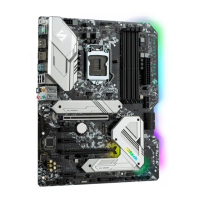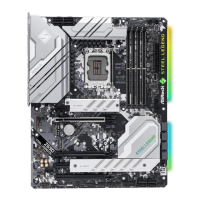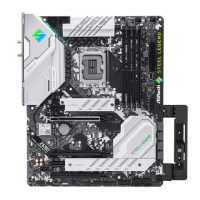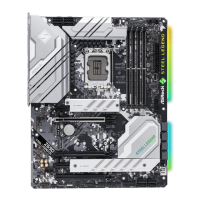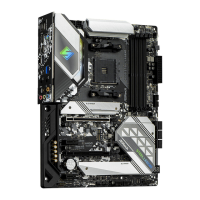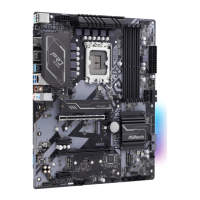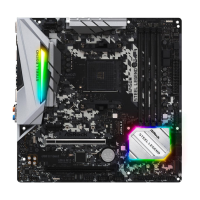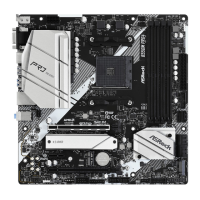Do you have a question about the ASROCK Z490 STEEL LEGEND and is the answer not in the manual?
Lists items included in the motherboard package.
Details the technical specifications of the motherboard, including CPU, memory, and expansion slots.
Illustrates the physical arrangement and labeling of motherboard components and connectors.
Describes the rear panel connectors and ports for external device connectivity.
Step-by-step guide for correctly installing the central processing unit onto the motherboard socket.
Instructions for mounting the CPU cooler assembly to dissipate heat effectively.
Guide on how to properly insert DDR4 memory modules into the motherboard slots.
Information on the available PCI Express slots and their configurations for expansion cards.
Explains the function and configuration of jumpers on the motherboard, like Clear CMOS.
Details the various pin headers and connectors on the motherboard for front panel and internal components.
Describes the function of the Post Status Checker for diagnosing boot issues.
Guide for installing and configuring two compatible graphics cards for CrossFireX.
Instructions for installing necessary drivers and software for graphics card functionality.
Steps for installing M.2 WiFi/BT modules or Intel® CNVi components.
Instructions for installing M.2 NVMe SSDs into the M2_1 slot.
Guide for installing M.2 NVMe SSDs into the M2_2 and M2_3 slots.
Guide to installing essential drivers and utilities from the support CD.
Introduction to ASRock's utility for system tuning, monitoring, and fan control.
Overview of the ASRock online store for software, apps, and driver updates.
Description of the Nahimic audio software for enhancing sound performance.
Utility for customizing RGB LED lighting effects.
Explains how to enter and navigate the UEFI BIOS setup utility.
Overview of the simplified dashboard interface for basic system status checks.
Access to detailed BIOS configurations and system settings.
Describes the main menu options available within the UEFI setup utility.
Lists the keyboard shortcuts for navigating and interacting within the UEFI utility.
Displays the system overview and basic information upon entering UEFI setup.
Section for configuring overclocking settings and performance tuning.
Comprehensive section for advanced system configuration options.
Settings related to CPU features, power management, and performance.
Configuration options for the motherboard's chipset and associated components.
Settings for managing storage devices like SATA and M.2 drives.
Configuration options for Intel Thunderbolt ports and related features.
Settings for Super IO chip features like PS/2 ports.
Advanced Configuration and Power Interface settings for power management.
Settings for managing USB ports and their functionalities.
Configuration for security features like Trusted Platform Module (TPM).
Access to utility tools like Instant Flash and RAID installers.
Monitors system hardware status, including temperatures, fan speeds, and voltages.
Settings for system security, including supervisor and user passwords.
Configures boot order, fast boot options, and other boot-related settings.
Options for saving changes, discarding changes, and exiting the UEFI utility.
Lists items included in the motherboard package.
Details the technical specifications of the motherboard, including CPU, memory, and expansion slots.
Illustrates the physical arrangement and labeling of motherboard components and connectors.
Describes the rear panel connectors and ports for external device connectivity.
Step-by-step guide for correctly installing the central processing unit onto the motherboard socket.
Instructions for mounting the CPU cooler assembly to dissipate heat effectively.
Guide on how to properly insert DDR4 memory modules into the motherboard slots.
Information on the available PCI Express slots and their configurations for expansion cards.
Explains the function and configuration of jumpers on the motherboard, like Clear CMOS.
Details the various pin headers and connectors on the motherboard for front panel and internal components.
Describes the function of the Post Status Checker for diagnosing boot issues.
Guide for installing and configuring two compatible graphics cards for CrossFireX.
Instructions for installing necessary drivers and software for graphics card functionality.
Steps for installing M.2 WiFi/BT modules or Intel® CNVi components.
Instructions for installing M.2 NVMe SSDs into the M2_1 slot.
Guide for installing M.2 NVMe SSDs into the M2_2 and M2_3 slots.
Guide to installing essential drivers and utilities from the support CD.
Introduction to ASRock's utility for system tuning, monitoring, and fan control.
Overview of the ASRock online store for software, apps, and driver updates.
Description of the Nahimic audio software for enhancing sound performance.
Utility for customizing RGB LED lighting effects.
Explains how to enter and navigate the UEFI BIOS setup utility.
Overview of the simplified dashboard interface for basic system status checks.
Access to detailed BIOS configurations and system settings.
Describes the main menu options available within the UEFI setup utility.
Lists the keyboard shortcuts for navigating and interacting within the UEFI utility.
Displays the system overview and basic information upon entering UEFI setup.
Section for configuring overclocking settings and performance tuning.
Comprehensive section for advanced system configuration options.
Settings related to CPU features, power management, and performance.
Configuration options for the motherboard's chipset and associated components.
Settings for managing storage devices like SATA and M.2 drives.
Configuration options for Intel Thunderbolt ports and related features.
Settings for Super IO chip features like PS/2 ports.
Advanced Configuration and Power Interface settings for power management.
Settings for managing USB ports and their functionalities.
Configuration for security features like Trusted Platform Module (TPM).
Access to utility tools like Instant Flash and RAID installers.
Monitors system hardware status, including temperatures, fan speeds, and voltages.
Settings for system security, including supervisor and user passwords.
Configures boot order, fast boot options, and other boot-related settings.
Options for saving changes, discarding changes, and exiting the UEFI utility.
| HDMI version | 1.4 |
|---|---|
| S/PDIF out port | Yes |
| PS/2 ports quantity | 1 |
| eSATA ports quantity | 0 |
| USB 2.0 ports quantity | 2 |
| Audio chip | Realtek ALC1200 |
| Certification | FCC, CE, ErP/EuP |
| Component for | PC |
| Motherboard chipset | Intel Z490 |
| PC health monitoring | FAN, Temperature, Voltage |
| Audio output channels | 7.1 channels |
| Motherboard form factor | ATX |
| Motherboard chipset family | Intel |
| Windows operating systems supported | Windows 10 |
| Number of SATA III connectors | 6 |
| PCI Express x1 (Gen 3.x) slots | 3 |
| OpenGL version | 4.5 |
| DirectX version | 12.0 |
| Maximum resolution | 4096 x 2304 pixels |
| Parallel processing technology support | CrossFireX, Quad-GPU CrossFireX |
| Wi-Fi | No |
| LAN controller | Dragon RTL8125BG |
| Ethernet interface type | 2.5 Gigabit Ethernet |
| BIOS type | UEFI AMI |
| ACPI version | 6.0 |
| BIOS memory size | 128 Mbit |
| System Management BIOS (SMBIOS) version | 2.7 |
| RAID levels | 0, 1, 5, 10 |
| Supported storage drive types | HDD & SSD |
| Supported storage drive interfaces | SATA III |
| Memory channels | Dual-channel |
| Memory slots type | DIMM |
| Number of memory slots | 4 |
| Supported memory types | DDR4-SDRAM |
| Maximum internal memory | 128 GB |
| Supported memory clock speeds | 2133, 2400, 2666, 2800, 2933, 3200, 3600, 3733, 3800, 3866, 4000, 4133, 4266, 4400 MHz |
| Compatible processor series | Intel Celeron, Intel Core i3, Intel Core i5, Intel Core i7, Intel Core i9, Intel Pentium |
| Cables included | SATA |
| Harmonized System (HS) code | 84733020 |
| Depth | 244 mm |
|---|---|
| Width | 305 mm |

